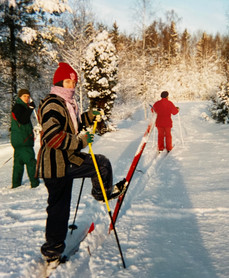Sweden tugs at me every year when the days grow short. The winter solstice and the festivities around it took on a new meaning in 1999 when I was invited to travel as far north as I've ever been during the darkest days of the year. While there, I was given a gift I brought back home with me. It has stayed alive all these years, and I find that it just keeps growing.
The December sun rose in a low arc above the horizon only six hours each day in Stockholm, a beautiful city of islands, waterways and buildings in shades of tan and salmon. Early one morning, way before dawn, we took the subway to the centre of town. It was pitch-dark inside the acoustically perfect, 16th century cathedral―St. Jakobs Kyrka. The nave was filled with people as we waited in hushed anticipation. Then the ethereal voices of an a capella choir sounded from far behind us. The candlelight procession gradually made its way to the front with a surround-sound harmony echoing from gothic arches. It was so beautiful that tears couldn’t help but flow. One young woman wore the St. Lucia crown of candles on her head. The other white-gowned youths held candles in their hands. Joakim was one of them.
Joakim had spent a year in Indiana as an exchange student and had been part of the youth group I helped supervise. When his parents, Lisbeth and Bengt, had visited him, I felt an immediate bond with them.
The next year Joakim returned to Sweden to complete his high school, and I started my own studies in Switzerland. Lisbeth and Bengt invited me up to Stockholm for the winter solstice and to see Joakim’s last St. Lucia Day performances with his choir. (He was a student at the Adolf Fredriks Musikklasser―an auditioned, music-focused high school.)

Joakim, along with 1200 talented students, also performed in the city's arena, the Globe. The concert took my breath away!
(*There are links below for YouTube clips of both St. Jakobs Kyrka and Globe performances from recent years.)

Lisbeth and Bengt wanted me to experience Swedish traditions with all the trimmings. They welcomed me into their home with a generosity I will never forget.
Back in Indiana, Joakim had introduced us to fika (FEE-kuh), which translates loosely as a coffee break and snacks with family or friends. I had not realized how sacrosanct fika is in Sweden. Twice a day, whether at work or home, everyone pauses for fika. . .and it was so much more than a coffee break.

In their home, the afternoon fika happened about 4pm. We'd fill our mugs with kaffee or cocoa and sit around a low table. Candles were lit. Knäckebröd (rye crispbread) was broken into shards to eat with hard cheese or a caviar spread that came from a squeeze tube. I loved the pepparkakar, (a thin, crisp, heart-shaped ginger cookie.) Lussekatter (a Lucia saffron bun) was served on December 13th, St Lucia Day.

Fika was something a family could count on. It was an intentional slowing down of the runaway pace our world has come to regard as “normal.” Each of us had time to share. Fika made space for re-centering and for really seeing each other and listening to what each person said.

My visit was scheduled to end a couple of days before Christmas. To my astonishment, Lisbeth had arranged with her extended family to have their traditional Christmas Eve celebration a week early. We drove several hours north to the Bergeå family home in Dalarna, where Lisbeth’s mother, Deborah, still lived.

Joakim offered his day to me, translating my conversations with their family and explaining about the traditional meanings embedded in the feast, itself.
I wondered how odd would it be for their family on the 24th of December that year, having generously given me the experience of Christmas Eve the week before. It was a remarkable act of kindness, for which there are no words to describe how it touched me.
The next day we chased the daylight as we drove to Lunån, where Lisbeth and her siblings had a cluster of cabins in a forest clearing. The snow was deep, and the sun had already set when we parked the car where the road ended at the edge of a forest.

I hadn’t understood that the only way to the cabin was by cross-country skis. They had brought a snowsuit and skis that fit me. We loaded up all the provisions and our own backpacks for the trek into the woods and through meadows in the dark. I was wobbly (and fell over a couple of times), but I learned to surrender my skis to the tracks blazed by those ahead of me. I remember deep cold, a nearly full moon illuminating the undulating drifts, and the glissade of five skiers making their way toward shelter. Once I relaxed, there was beauty in the quiet rhythm of it.

The cabin was freezer-cold at first, but a fire was lit in the huge wood burner. By the time my sweat-soaked layers had dried out I'd fallen in love with this charming log home Bengt and Lisbeth had built with their own hands. The fleeting hours of sunlight on the winter solstice were spent skiing. In my memory, their cabin at Lunån is one of the loveliest places on earth.
The hospitality I experienced from Lisbeth, Bengt, and their family was an extraordinary gift. How can such a gift of love not stay in one's heart and keep growing there?
~ K L Kurtz


*Below are YouTube clips of Lucia Day performances by the Adolf Fredriks’ high school choir in more recent years. They bring back, for me, the experiences I had in 1999.
St Jakobs Kyrka: https://www.youtube.com/watch?v=jEf7OXYng_0
The Globe: https://www.youtube.com/watch?v=83Cp7xQmmr0

Every year I bake ginger cookies using a recipe from Lisbeth's kitchen. They are best when dipped in Joakim's hot chocolate (made from a thick paste of heavy cream, cocoa powder & a bit of sugar before adding hot water– the way he taught us the year he lived in Indiana.)
Below is a glossary of foods for fika:
















Comments